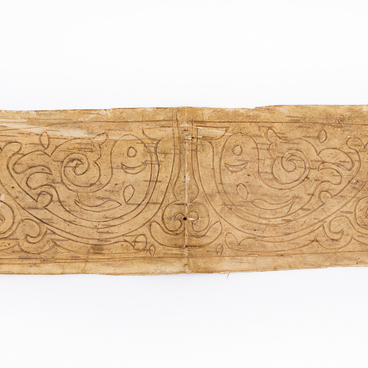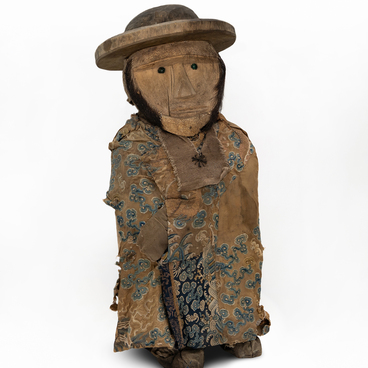The ornament on the blue painted fish skin, presented in the collection, was sewn on a white cotton fabric with small stitches. Such ornaments were created to decorate robes. This pattern is of a spiral-ribbon type, and the spiral elements were united by the artist into a single ornament with a narrow line.
Fish skin is considered one of the oldest materials that humans have mastered and learned to process perfectly. It was widely used: clothes and writing materials were created from it. This feature was inherent in ethnic groups, in whose life fishing was the main occupation.
The Nanai ornament had a long history of development, its origins can be traced back to the Neolithic era. Over many centuries, for this indigenous Far Eastern people, such patterns represented more than just a decorative tool: they were an ancient sign system that united the broad knowledge of all previous generations about the world and society.
The backs of the robes were created as a kind of book, which contained information about the worlds: upper, middle and lower, about the creation of the earth and all living things, about a particular clan. The most complex spirals were combined into images of the world tree, dragons, birds, fish, snakes, creating, according to beliefs, a powerful protective field for generations. Some of the ornaments were painted with natural dyes.
In the Nanai culture, spirals were present almost everywhere, on objects of any purpose and on any material. Zoomorphic images were woven into the main canvas of spiral ribbon patterns. They were almost always stylized, but at the same time they retained the characteristic movements, postures and characters of animals, captured by the artist — a native forest dweller, hunter and fisher.
Dealing with the images
of animals in the Nanai ornament, in most cases the artist painted their
profile silhouette. This applied to images of birds (except the eagle), forest
animals: deer, Manchurian wapiti, hare, sable, as well as fish. Small
representatives of fauna — reptiles and insects — were fixed by the artist’s
gaze from above, as if flattened out. Finally, a narrow ribbon or line combined
all this into a single system.




